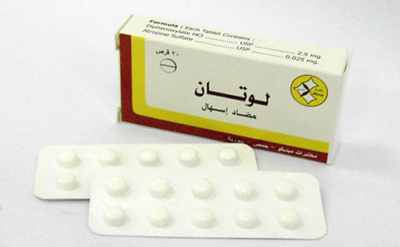Description:
Diphenoxylate is rapidly and extensively metabolized in man by ester hydrolysis to diphenoxylic acid (difenoxine), which is the major metabolite in the blood and biologically active. An average of 14% of the drug plus its metabolites were excreted in the urine and 49% in the faeces over a 4-day period. Urinary excretion of the unmetabolized drug constituted less than 1% of the dose, and diphenoxylic acid plus its glucuronide conjugate constituted about 6% of the dose. The average peak plasma concentration of diphenoxylic acid following ingestion of four 2.5 mg tablets was 163 ng/mL at about 2 hours, and the elimination half-life of diphenoxylic acid was approximately 12 to 14 hours.
Diphenoxylate hydrochloride and atropine sulfate tablets are effective as adjunctive therapy in the management of diarrhea
Diphenoxylate hydrochloride and atropine sulfate tablets are contraindicated in patients with:
- Known hypersensitivity to diphenoxylate or atropine
- Obstructive jaundice
- Diarrhea associated with pseudomembranous enterocolitis or enterotoxin-producing bacteria.
- This is not an innocuous drug and dosage recommendations should be strictly adhered to.
- Overdosage may result in severe respiratory depression and coma, possibly leading to permanent brain damage or death. Therefore keep this medication out of the reach of the children.
- The use of this product should be accompanied by appropriate fluid and electrolyte therapy, when indicated. If severe dehydration or electrolyte imbalance is present, this product should be withheld until appropriate corrective therapy has been initiated. Drug-induced inhibition of peristalsis may result in fluid retention in the intestine, which may further aggravate dehydration and electrolyte imbalance.
- Antiperistaltic agents may prolong and/or worsen diarrhea associated with organisms that penetrate the intestinal mucosa (toxigenic coli, Salmonella, Shigella), and pseudomembranous enterocolitis associated with broad-spectrum antibiotics. Antiperistaltic agents should not be used in these conditions.
- In some patients with acute ulcerative colitis, agents that inhibit intestinal motility or prolong intestinal transit time have been reported to induce toxic megacolon. Consequently, patients with acute ulcerative colitis should be carefully observed and therapy should be discontinued promptly if abdominal distention occurs or if other untoward symptoms develop.
- This product should be used with extreme caution in patients with advanced hepatorenal disease and in all patients with abnormal liver function since hepatic coma may be precipitated.
- Drug Abuse and Dependence: In doses used for the treatment of diarrhea, whether acute or chronic, diphenoxylate has not produced addiction. Diphenoxylate hydrochloride is devoid of morphine-like subjective effects at therapeutic doses. The dose which produces antidiarrheal action is widely separated from the dose which causes central nervous system effects. Since addiction to diphenoxylate hydrochloride is possible at high doses, the recommended dosage should not be exceeded
- The patient should be cautioned regarding activities requiring mental alertness, such as driving or operating dangerous machinery
Drug interactions:
- Diphenoxylate hydrochloride may potentiate the action of barbiturates, tranquilizers, and alcohol. Therefore, the patient should be closely observed when any of these are used concomitantly.
- Since the chemical structure of diphenoxylate hydrochloride is similar to that of meperidine hydrochloride, the concurrent use of this product with monoamine oxidase (MAO) inhibitors may, in theory, precipitate hypertensive crisis
- diphenoxylate has the potential to prolong the biological half-lives of drugs for which the rate of elimination is dependent on the microsomal drug metabolizing enzyme system.
Pregnancy:
Pregnancy Category C: There are no adequate and well controlled studies in pregnant women. This product should be used during pregnancy only if the anticipated benefit justifies the potential risk to the fetus.
Nursing Mothers:
Caution should be exercised when this product is administered to a nursing woman, since the physicochemical characteristics of the major metabolite, diphenoxylic acid, are such that it may be secreted in breast milk and since it is known that atropine is secreted in breast milk.
At therapeutic doses, the following have been reported:
Nervous system: Numbness of extremities, euphoria, depression, malaise/lethargy, confusion, sedation/drowsiness, dizziness, restlessness, headache.
Allergic: anaphylaxis, angioneurotic edema, urticaria, swelling of the gums, pruritus.
Gastrointestinal system: toxic megacolon, paralytic ileus, pancreatitis, vomiting, nausea, anorexia, abdominal discomfort.
The following atropine sulfate effects are listed in decreasing order of severity, but not of frequency: hyperthermia, tachycardia, urinary retention, flushing, dryness of the skin and mucous membranes. These effects may occur especially in children.
Adults: The recommended initial dosage is two tablets four times daily (20 mg per day). Most patients will require this dosage until initial control has been achieved, after which the dosage may be reduced to meet individual requirements. Control may often be maintained with as little as 5 mg (two tablets) daily.
Clinical improvement of acute diarrhea is usually observed within 48 hours. If clinical improvement of chronic diarrhea after treatment with a maximum daily dose of 20 mg of diphenoxylate hydrochloride is not observed within 10 days, symptoms are unlikely to be controlled by further administration.
Children: it should not be used in children
OVERDOSAGE
Diagnosis: Initial signs of overdosage may include dryness of the skin and mucous membranes, mydriasis, restlessness, flushing, hyperthermia, and tachycardia followed by lethargy or coma, hypotonic reflexes, nystagmus, pinpoint pupils, and respiratory depression. Respiratory depression may be evidenced as late as 30 hours after ingestion and may recur in spite of an initial response to narcotic antagonists. Treat all possible overdosages as serious and maintain medical observation for at least 48 hours, preferably under continuous hospital care.
Treatment: In the event of overdose, induction of vomiting, gastric lavage, establishment of a patent airway, and possibly mechanically assisted respiration are advised. activated charcoal may significantly decrease the bioavailability of diphenoxylate. In non-comatose patients, a slurry of 100 g of activated charcoal can be administered immediately after the induction of vomiting or gastric lavage.
A pure narcotic antagonist (e.g., naloxone) should be used in the treatment of respiratory depression caused by diphenoxylate hydrochloride and atropine sulfate. When a narcotic antagonist is administered intravenously, the onset of action is generally apparent within 2 minutes. It may also be administered subcutaneously or intramuscularly, providing a slightly less rapid onset of action but a more prolonged effect.
Storage condition : store up to25°C
Packaging : Box contains 20 Tablets

